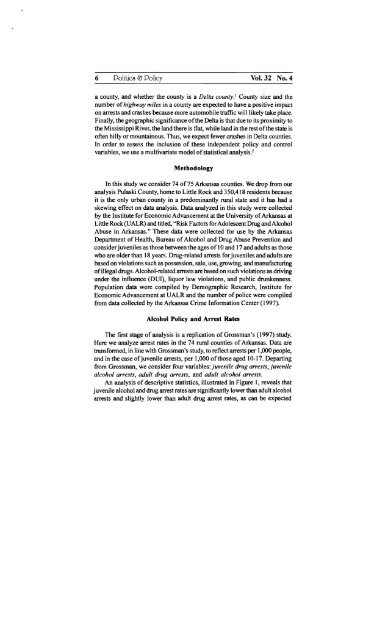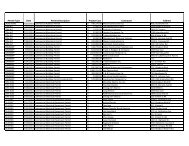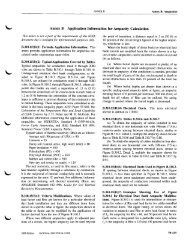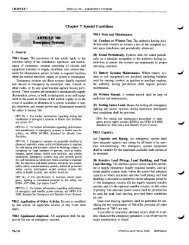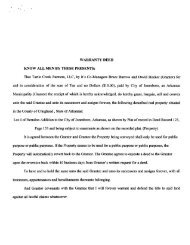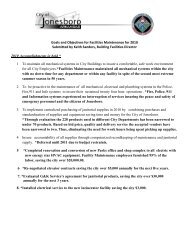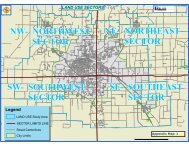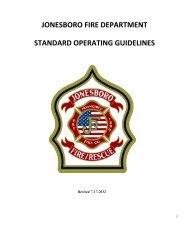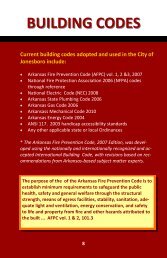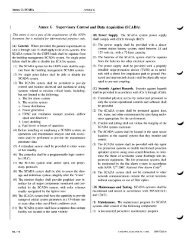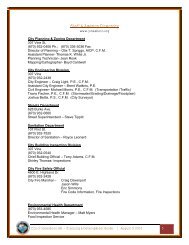Opposition material - City Clerk - City of Jonesboro
Opposition material - City Clerk - City of Jonesboro
Opposition material - City Clerk - City of Jonesboro
Create successful ePaper yourself
Turn your PDF publications into a flip-book with our unique Google optimized e-Paper software.
6 Politics 0 Policy Vol. 32 No.4<br />
a county, and whether the county is a Delta county.] County size and the<br />
number <strong>of</strong>highway miles in a county are expected to have a positive impact<br />
on arrests and crashes because more automobile traffic will likely take place.<br />
Finally, the geographic significance <strong>of</strong>the Delta is that due to its proximity to<br />
the Mississippi River, the land there is flat, while land in the rest <strong>of</strong>the state is<br />
<strong>of</strong>ten hilly or mountainous. Thus, we expect fewer crashes in Delta counties.<br />
In order to assess the inclusion <strong>of</strong> these independent policy and control<br />
variables, we use a multivariate model <strong>of</strong>statistical analysis. 2<br />
Methodology<br />
In this study we consider 74 <strong>of</strong>75 Arkansas counties. We drop from our<br />
analysis Pulasld County, home to Little Rock and 350,418 residents because<br />
it is the only urban county in a predominantly rural state and it has had a<br />
skewing effect on data analysis. Data analyzed in this study were collected<br />
by the Institute for Economic Advancement at the University <strong>of</strong>Arkansas at<br />
Little Rock (UALR) and titled, "Risk Factors forAdolescent Drug andAlcohol<br />
Abuse in Arkansas." These data were collected for use by the Arkansas<br />
Department <strong>of</strong> Health, Bureau <strong>of</strong>Alcohol and Drug Abuse Prevention and<br />
consider juveniles as those between the ages <strong>of</strong> 10 and 17 and adults as those<br />
who are older than 18 years. Drug-related arrests for juveniles and adults are<br />
based on violations such as possession, sale, use, growing, and manufacturing<br />
<strong>of</strong>illegal drugs. Alcohol-related arrests are basedon such violations as driving<br />
under the influence (DUI), liquor law violations, and public drunkenness.<br />
Population data were compiled by Demographic Research, Institute for<br />
Economic Advancement at UALR and the number <strong>of</strong>police were compiled<br />
from data collected by the Arkansas Crime Information Center (1997).<br />
Alcohol Policy and Arrest Rates<br />
The first stage <strong>of</strong> analysis is a repl ication <strong>of</strong> Grossman's (1997) study.<br />
Here we analyze arrest rates in the 74 rural counties <strong>of</strong>Arkansas. Data are<br />
transfonned, in line with Grossman's study, to reflect arrests per 1,000 people,<br />
and in the case <strong>of</strong>juvenile arrests, per 1,000 <strong>of</strong>those aged 10-17. Departing<br />
from Grossman, we consider four variables:juvenile drug arrests, juvenile<br />
alcohol arrests, adult drug arrests, and adult alcohol arrests.<br />
An analysis <strong>of</strong> descriptive statistics, illustrated in Figure I, reveals that<br />
juvenile alcohol and drug arrest rates are significantly lower than adult alcohol<br />
arrests and slightly lower than adult drug arrest rates, as can be expected


